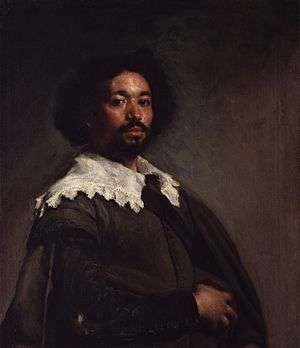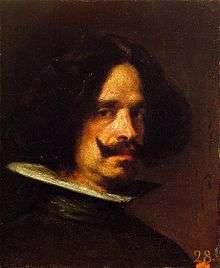Portrait of Juan de Pareja
 | |
| Artist | Diego Velázquez |
|---|---|
| Year | c. 1650 |
| Medium | Oil on canvas |
| Dimensions | 81.3 cm × 69.9 cm (32.0 in × 27.5 in) |
| Location | Metropolitan Museum of Art, New York City |
The Portrait of Juan de Pareja is a painting by Spanish artist Diego Velázquez, dating from around 1650 and currently on display at the Metropolitan Museum of Art in New York City.
History
In 1648, as court painter to Philip IV of Spain, Diego Velázquez was sent to Rome to purchase works of art for the Alcázar in Madrid. Velázquez brought with him Juan de Pareja, a slave, who served as an assistant in the artist's workshop.[1] During his stay in Rome, Velázquez executed an oil portrait of Juan de Pareja, which was displayed as part of a larger exhibition of paintings at the Pantheon on 19 March 1650. According to Antonio Palomino's biography of Velázquez, the painting "was generally applauded by all the painters from different countries, who said that the other pictures in the show were art but this one alone was 'truth'."[2]
Velázquez painted the portrait of Juan de Pareja, who was of Moorish descent,[3] in his workshop, as an exercise in preparation for his official portrait of Pope Innocent X. The Pope, a ruddy-faced man who would be depicted in the bright pink and crimson robes of his office, presented a tricky study in both color and composition. Additionally, since he would be executing a portrait from life, Velázquez would be forced to work quickly while still capturing the essence of Innocent X's character. The Juan de Pareja reflects Velázquez's exploration of the difficulties he would encounter in the Pope's portrait. To compensate for a restricted palette of colors, Velázquez adopted a loose, almost impressionistic style of brushwork to bring an intense vitality to his subject.
Juan de Pareja (circa 1610 – 1670) became an artist in his own right, and in 1654 he was freed by Velázquez.[4]
The Portrait of Juan de Pareja was purchased by the Metropolitan Museum in 1971. At the time, the purchase price of over $5.5 million set a new record for paintings at auction. This became a source of some controversy both for the museum and for its director, Thomas Hoving, who spearheaded the effort to acquire the work and considered it one of the finest paintings in the museum's collection.
References
Sources
- Hoving, Thomas (1993). Making the Mummies Dance. Simon and Schuster.
- Palomino, Antonio (1724). El Museo pictórico y escala óptica.
- Borton de Treviño, Elizabeth (1965). I, Juan de Pareja. Bell Books. ASIN B0006BN0A0.
External links
- Juan de Pareja by Diego Velázquez: an appreciation of the portrait, a fully digitized book about this painting from The Metropolitan Museum of Art
- Velázquez's Juan de Pareja at the Metropolitan Museum of Art
- Velázquez , exhibition catalog from The Metropolitan Museum of Art (fully available online as PDF), which contains material on this portrait (see index)
